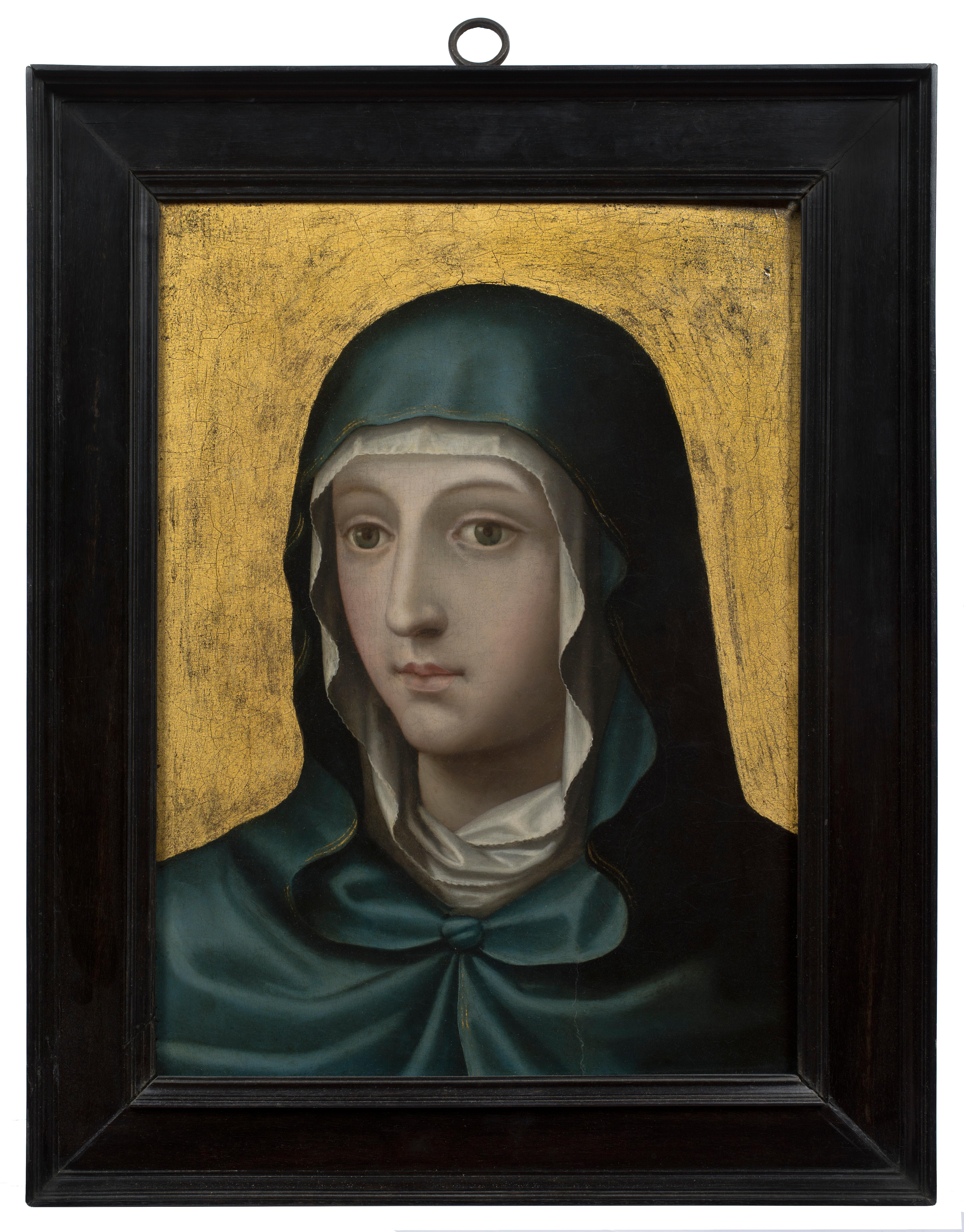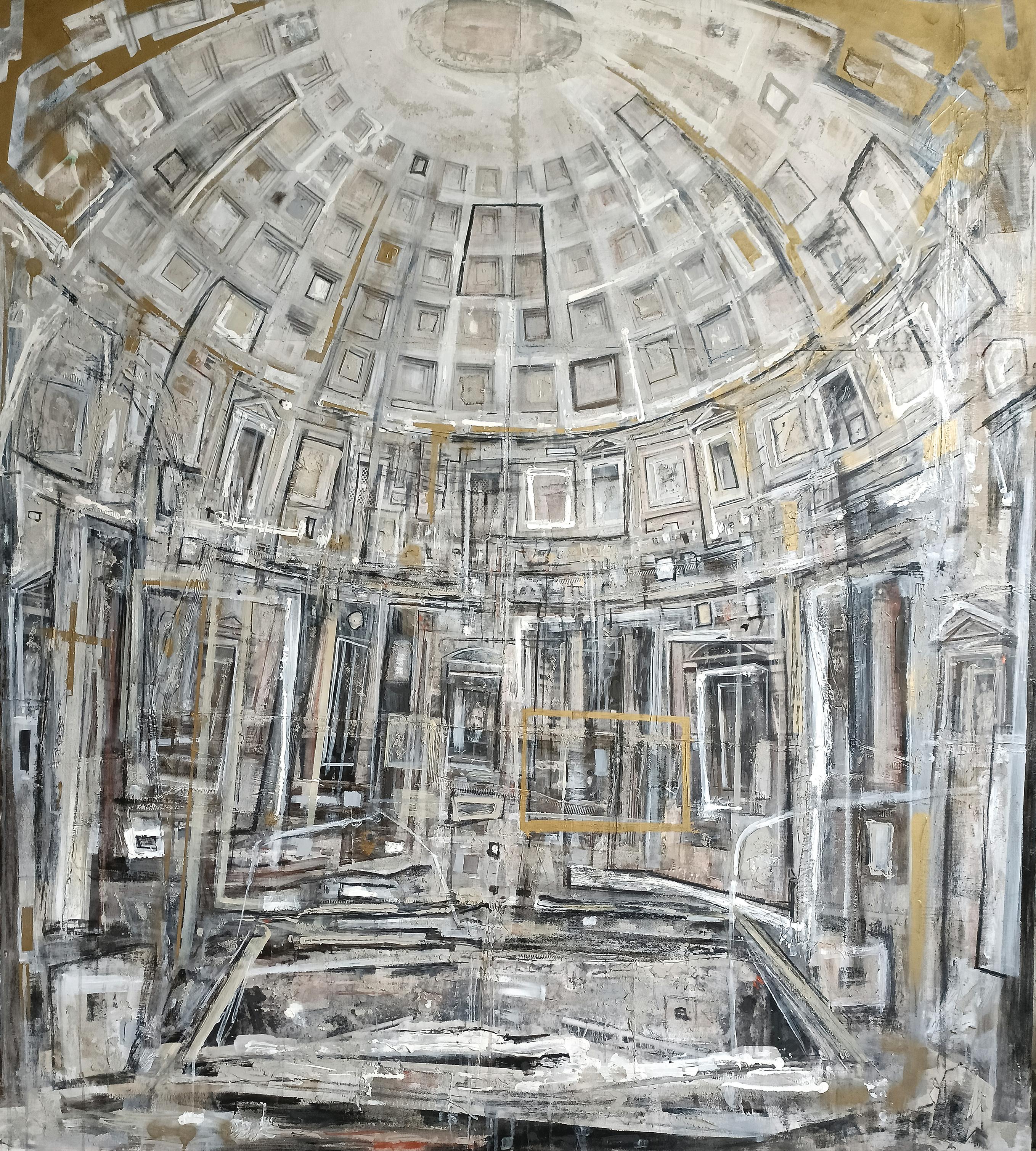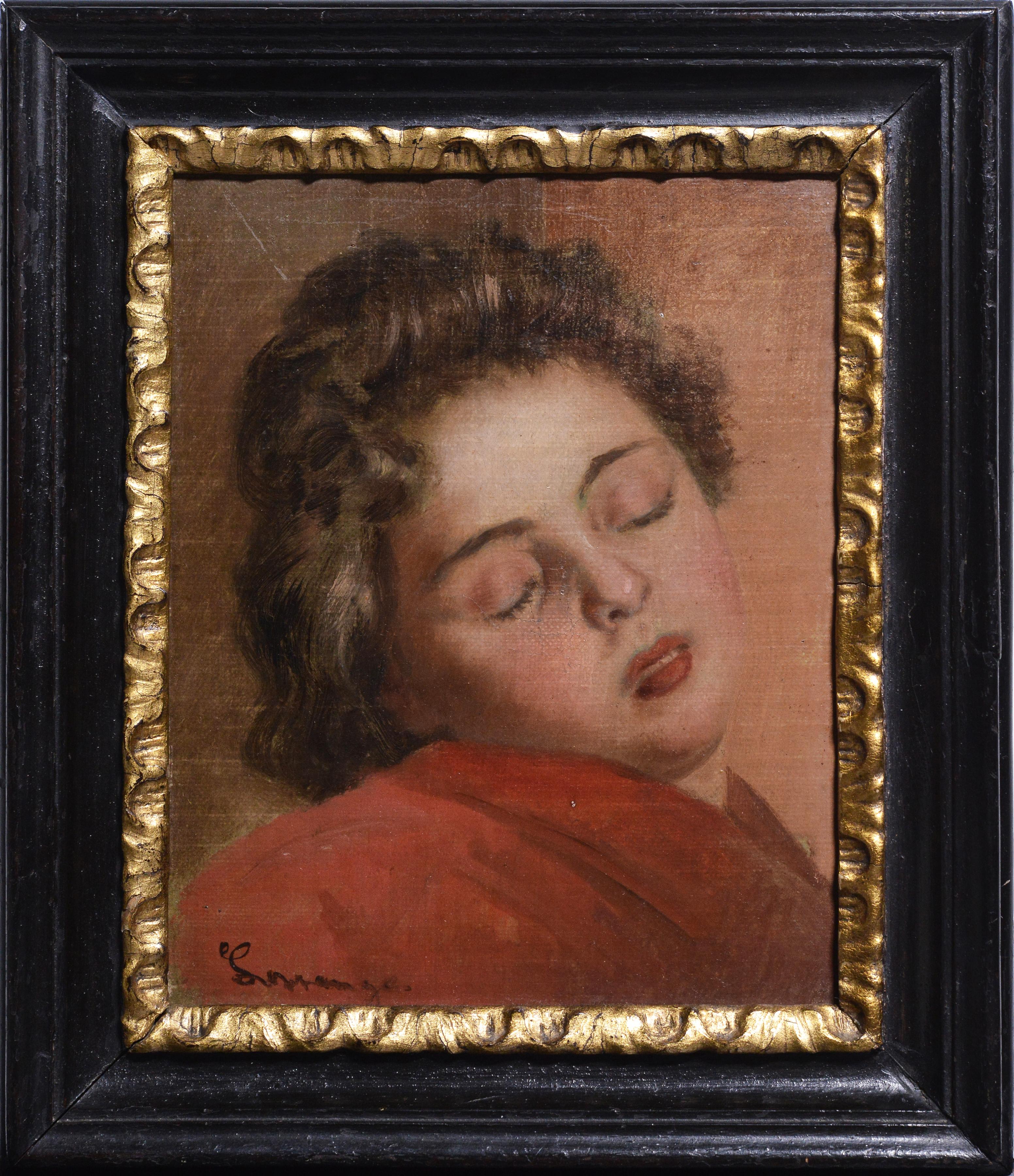Items Similar to King Solomon Worshipping The Idols, 17th Century FRANS FRANCKEN II (1581-1642)
Want more images or videos?
Request additional images or videos from the seller
1 of 11
Frans Francken IIKing Solomon Worshipping The Idols, 17th Century FRANS FRANCKEN II (1581-1642)
About the Item
King Solomon Worshipping The Idols, 17th Century
FRANS FRANCKEN II (1581-1642) - signed sales to $6,000,000
Large 17th Century biblical account of King Solomon worshipping the Idols, oil on panel Frans Francken. Excellent quality and condition Old Testament biblical scene on a cradled panel depicting the Idolatry of Solomon, son and successor of King David. Exceptional detail and would be enhanced with a light clean. Presented in an antique period frame. Signed.
Measurements: 47" x 34" framed approx
Artist Biography
Frans Francken II or the Younger is the third in order of descent in the Francken family tree. Born in 1581, the son of Frans Francken I or the Elder, he was the brother of Thomas, born in 1574, of Hieronymous II, born in 1578 and died in 1623, and of Ambrosius II, the last in line, who died in 1632. Hieronymous II, who died at the age of 56, is only known for his painting Horatius Cocles at Sublicius Bridge. Frans the Younger was initially a pupil of his father, who was then at the height of his career. In his father's studio he imbibed all the teaching of the tradition of Frans Floris. He also spent long periods in Italy, where he familiarised himself in particular with the masters of the Venetian school. Such study in situ enabled him to break away from the well-worn methods of Flemish Italianism, as practised by his father and uncles. It is conceivable that the young artist met Rubens, who was in Italy at the time.
In 1605, at the age of 24, on his return to Antwerp, Frans the Younger became a master in the Antwerp Guild of St Luke. In 1607 he married Elisabeth Placquet in Antwerp. Three sons and eight daughters resulted from this marriage. His children made up the fourth generation in the dynasty. Better known are Frans III (1607-1667) and Hieronymus, born in 1611. The latter had a son, Constantinus (1661-1717), who marks the end of the line. The family of Francken painters runs from 1520 to 1717.
As one of the most active masters in Antwerp, Frans II was appointed dean of the guild in 1614. He was also a member of the Violette, a major literary association, for which he painted an award-winning symbolic coat of arms. He was intimate with the most celebrated artists, in particular van Dyck, who executed a very fine portrait of him, judging by the engraving by Willem Hondius and Pieter de Jode. It is also likely that he was on familiar terms with Rubens who was his near contemporary. He died in Antwerp on 6 May 1642 at the age of 61, outlived by both Rubens and van Dyck.
The first securely dated work of Frans the Younger is Christ on the Cross from the gallery in Vienna, painted in 1606. Witches' Sabbath (Vienna) and The Works of Mercy (Antwerp) are dated 1607 and 1608 respectively. In these two latter works the painter proves himself adept at painting figures and allegorical scenes. The Works of Mercy represents various groups of figures, symbolising the different activities inspired by Christian charity. Paupers and beggars occupy the foreground, the ensemble being dominated by the figure of the glorious Christ.
While Frans the Younger cannot be compared with the masters of this great first generation of Antwerp, which was illuminated and steered by the genius of Rubens, he does nevertheless merit attention. He succeeded in developing and bringing into fashion an anecdotal genre on a more modest scale, elements of which were to inform the last representatives of the Francken family for over a century. Frans the Younger was undoubtedly the most talented draughtsman in the family. While his art may be criticised for its lack of grandeur and solemnity, the execution shows great talent. His brush stroke was vigorous and his imagination, albeit restrained, was brilliant. His interest in tonal values was highlighted by his study and appreciation of his remarkable contemporaries. This enabled him to carry out landscapes and also fleshy figures, which made him altogether worthy of the brilliant period to which he belonged. While detail certainly preoccupied him, he treated it with intelligence and even esprit, as witnessed in The Parable of the Prodigal Son and A Prince's Visit to the Treasury of a Church(both in the Louvre). The scenes painted in grisaille, which surround the principal motif of the Prodigal Son, are characteristic of his style. He excelled in painting jewellery, ornaments, and textiles with shot silk effects. A large number of his figures inhabit the neutral backgrounds of the interiors of apartments and galleries. He carried out such work not only under his own auspices, but also for other artists, such as Peeter Neeffs, van Bassen, Josse de Momper, and Breughel.
Museum and Gallery Holdings
Aix: Arrival of the Hebrews in the Promised Land
Amiens: Adoration of the Magi (sketch)
Amsterdam: Abdication of Charles V of Spain; Adoration of the Magi; The Prodigal Son; Same Subject; Scenes from the Old Testament
Antwerp: A Collector's Cabinet; Miracles at the Tomb of St Bruno; The Works of Mercy; The Four Crowned Martyrs Condemned; Flagellation of the Four Crowned Martyrs; Stoning; The Four Crowned Martyrs at Work
Arras: The Passion
Augsburg: Moses Striking Water from the Rock
Bamberg: The Festival of Dancing
Besançon: The Crossing of the Red Sea; Crossing the Jordan; Christ Delivered to the Insults of the Jews; Christ Carrying the Cross
Bordeaux: Christ at Calvary; Same Subject
Brussels: Croesus Showing Solon his Treasures
Budapest: Esther and Ahasuerus
Caen: The Slaves of the Furies of Love
Chambéry (MBA): Adoration of the Magi
Cherbourg: The Woman Taken in Adultery
Cologne: Adoration of the Magi
Compiègne: Allegory
Dresden: The Calumny of Apelles; The Flight into Egypt; The Queen of the Heavens Crowned with Flowers; The Adultress before Christ; The Creation of Eve
Dunkirk: The Feast of Herod
Florence (Palazzo Pitti): Christ Led to Calvary
Florence (Uffizi): The Flight into Egypt
Hamburg: Drowning of Pharoah's Army
Hanover: The Prodigal Son
Kassel: The Kiss of Judas (copper)
Kassel (Gemäldegal. Alte Meister): Apelles and the Cobbler (copper)
Lille: Christ on the Way to Calvary
Mainz: David, Conqueror of Goliath
Munich: room decorated with pictures and objets d'art; The Seven Works of Mercy; A Tournament
Nancy: The Virgin and Child Served by Angels; Christ in the Desert Served by the Angels
Nantes (MBA): The Embarkation of Cleopatra; The Death of Adonis
Nice: Christ in the Garden of Gethsemane
Oberschleissheim: The Temptation of St Anthony
Oldenburg (Augusteum): Apollo and the Muses
Orléans: Christ before Caiaphus
Oslo: Gathering of Men and Women in front of an Inn
Paris (Louvre): The Parable of the Prodigal Son; The Passion; Ulysses Recognises Achilles amongst the Daughters of Lycomedes; Croesus and Solon
Paris (Mus. Marmottan-Monet): Christ Preaching on the Sea of Tiberias
Rennes: Christ in the House of Simon the Pharisee
Rohrau (Schlossmuseum, Graf Harrach'sche Familiensammlung): Studio (allegorical subject)
Rome (Mus. e Gal. Borghese): Picture Dealer
St Petersburg (Hermitage): Crossing the Red Sea; The Seven Acts of Christian Mercy; Entry of David into Jerusalem
Stockholm: six paintings
Stuttgart: Adoration of the Magi; Last Judgement; The Four Elements; Jupiter and Juno
The Hague: A Ball at the Court of Albert and Isabelle
Tours: The Abduction of Helen
Vienna: Witches' Sabbath; Croesus and Solon; The Dance; The Crucifixion; Christ and Nicodemus; A Cabinet of Art and Curiosities (1636); Gathering of Witches
Bibliography
Härting, Ursula Alice: Studien zur Kabinettbildmalerei des Frans Francken II, 1581-1642. Ein Repräsentativer Werkkatalog, G. Olms, Hildesheim, 1983.
Härting, Ursula Alice: Frans Francken der Jüngere (1581-1642): die Gemälde mit Kritischen Oeuvrekatalog, catalogue raisonné, Luca Verlag, Freren, 1989 (with a summary in English).
- Creator:Frans Francken II (1581 - 1642, Flemish)
- Dimensions:Height: 34 in (86.36 cm)Diameter: 47 in (119.38 cm)
- Medium:
- Period:
- Condition:
- Gallery Location:Blackwater, GB
- Reference Number:
About the Seller
4.8
Platinum Seller
These expertly vetted sellers are 1stDibs' most experienced sellers and are rated highest by our customers.
Established in 2008
1stDibs seller since 2021
196 sales on 1stDibs
Typical response time: 1 hour
- ShippingRetrieving quote...Ships From: Blackwater, United Kingdom
- Return PolicyA return for this item may be initiated within 14 days of delivery.
More From This SellerView All
- Portrait Of King Edward VI (1537-1553) as Prince Of Wales, 16th CenturyLocated in Blackwater, GBPortrait Of King Edward VI (1537-1553) as Prince Of Wales, 16th Century English School - Oil on panel - circa 1547 Large 16th Century portrait of Edward VI as Prince Of Wales, oil...Category
16th Century Portrait Paintings
MaterialsWood Panel, Oil
- Portrait Of Elizabeth Percy, Countess of Northumberland (1646-1690) 17th CenturyBy Daniel MytensLocated in Blackwater, GBPortrait Of Elizabeth Percy, Countess of Northumberland (1646-1690), 17th Century Studio of Jan MYTENS (1640-1670) Large 17th portrait of Elizabeth Percy Countess of Northumberlan...Category
17th Century Portrait Paintings
MaterialsWood Panel, Oil
- The Blood Of Christ, The Milk Of The Madonna, 16th CenturyLocated in Blackwater, GBThe Blood Of Christ, The Milk Of The Madonna, 16th Century circle of Adriaen Isenbrandt (1480-1551) Huge 16th Century Flemish old Master depiction of...Category
16th Century Portrait Paintings
MaterialsOil, Wood Panel
- The Hunting Party, Scottish Moors, 19th Century by ROBERT CLEMINSON (1844-1902Located in Blackwater, GBThe Hunting Party, Scottish Moors, 19th Century by ROBERT CLEMINSON (1844-1902) similar to $15,000 Large 19th century Scottish Moors Hunting Party, oil on canvas by Robert Clemins...Category
19th Century Portrait Paintings
MaterialsOil, Wood Panel
- Coronation Portrait Of King Edward VI (1537-1553) as King Of England & IrelandLocated in Blackwater, GBCoronation Portrait Of King Edward VI (1537-1553) as King Of England & Ireland, 16th Century English School - Oil on panel - circa 1547 Large 16th Century Coronation portrait of E...Category
16th Century Portrait Paintings
MaterialsWood Panel, Oil
- Portrait Of Baron Dudley North, 16th Century English SchoolLocated in Blackwater, GBPortrait Of Baron Dudley North, 16th Century English School Huge 16th Century Portrait of Dudley North, 3rd Baron North, attired for an Accession Day Tilt with a favour, traditiona...Category
16th Century Portrait Paintings
MaterialsOil, Panel
You May Also Like
- The Veronica of the Virgin (Verónica de la Virgen)Located in New York, NYThe panel has been attributed both to Joan de Joanes and his son Vicente Macip Comes (Valencia, ca. 1555 – 1623). Provenance: Private Collection, England, by 1886 (according to stencils on the reverse) Private Collection, New Jersey, until 2010 The Veil of Veronica, often called the Sudarium, is one of the most important and well-known relics of Christ. According to legend, Veronica offered Christ her veil as he carried the cross to his crucifixion. He wiped his face with the veil, which left the cloth miraculously imprinted with his image. Depictions of Christ’s face on a veil, or simply images that focused in on Christ’s face, were treasured objects of religious devotion. The popularity of this format also inspired similar images of the face of the Virgin. The iconographic type of the present painting is known as the Veronica of the Virgin, which was especially favored in late medieval and early Renaissance Spain. Distinct from the images of the suffering Christ, the Veronica of the Virgin is based on the legend that Saint Luke painted a portrait of Mary from life. Although scholars have sometimes mistaken them for portraits of Queen Isabella I of Castile (known as Isabel la Católica) or as a depiction of Saint Maria Toribia (known as María de la Cabeza, or, Mary of the Head), paintings like this one were clearly intended as images of the Virgin in the style of Saint Luke’s lost portrait. The Veronica of the Virgin was especially popular in Valencia, and depictions of this subject produced there all stem back to one visual prototype: a Byzantine image in the city’s cathedral (Fig. 1). This early treatment of the Veronica was given to the cathedral in 1437 by Martin the Humane, King of Aragon and Valencia, who promoted religious veneration of the Veronica of the Virgin as part of the celebration of the Immaculate Conception of Mary. This devotion spread throughout Martin’s kingdom and particularly took hold in Valencia, where the Byzantine image resided. The image, which is displayed in a gold reliquary...Category
16th Century Old Masters Paintings
MaterialsOil, Wood Panel
- 18th Century Venetian School Portrait of a Bishop Oil on Panel Green Brown BlackLocated in Sanremo, ITPainting oil on panel measuring 40 x 30 cm without frame and 48 x 38 with frame representing a great bishop of the Venetian school from the first half of the 18th century. Very curi...Category
Early 18th Century Italian School Portrait Paintings
MaterialsOil, Wood Panel
- Torre VelascaLocated in Milano, MIUrbex is the English acronym for urban exploration and is an activity that consists of searching for and locating abandoned infrastructure with the goal of visiting, photographing and conveying its contents, with particular involvement of methodologies from geography, anthropology, sociology to cultural studies. Her works have been in the past approached to the works of Anselm Kiefer (b. 1945) and Giovanni Battista Piranesi (1720-1770), but in Gullotta's paintings the absence of color makes the spaces particularly ethereal, allowing them to be ideally lifted to new places and to new life. An artist of international caliber who has decided to entrust her return to her homeland to Almach Art Gallery in Milan, while maintaining connections with important galleries, such as Marlborough Fine Art in London and Galerie Koch in Hanover. The artwork represents the famous Velasca Tower in Milan. This artwork was exhibited during the Daniela Gullotta...Category
2010s Contemporary Portrait Paintings
MaterialsSandstone
- PantheonLocated in Milano, MIUrbex is the English acronym for urban exploration and is an activity that consists of searching for and locating abandoned infrastructure with the goal of visiting, photographing and conveying its contents, with particular involvement of methodologies from geography, anthropology, sociology to cultural studies. Her works have been in the past approached to the works of Anselm Kiefer (b. 1945) and Giovanni Battista Piranesi (1720-1770), but in Gullotta's paintings the absence of color makes the spaces particularly ethereal, allowing them to be ideally lifted to new places and to new life. An artist of international caliber who has decided to entrust her return to her homeland to Almach Art Gallery in Milan, while maintaining connections with important galleries, such as Marlborough Fine Art in London and Galerie Koch in Hanover. The artwork represents the famous Velasca Tower in Milan. This artwork was exhibited during the Daniela Gullotta...Category
2010s Contemporary Portrait Paintings
MaterialsSandstone
- Portrait Sleeping Girl by Danish German Genre Painting Master 19th centuryLocated in Stockholm, SEJohann August Frederik Carl Lorange (1833 - 1875) was highly skilled Danish artist of German roots. Not much known on his biography, unfortunately, but most of his works were produc...Category
19th Century Realist Portrait Paintings
MaterialsCanvas, Wood, Oil, Wood Panel
- A SecretLocated in Bogotá, BogotáFigurative Magical Painting, textured mixed technique, created in 2021. This piece represents one of my earlier works, exploring our connection with animals through a human and magic...Category
2010s Contemporary Portrait Paintings
MaterialsOil, Wood Panel





